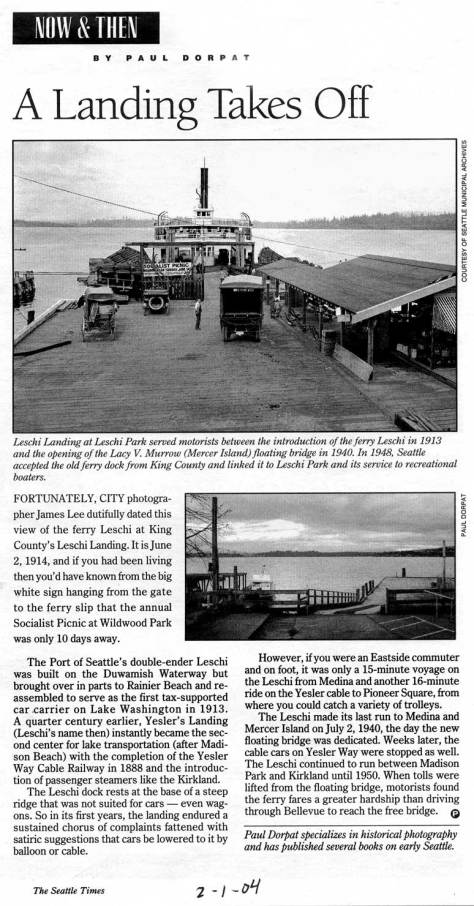(click to enlarge photos)


Judging merely from the motorcars parked below the hanging Shell sign in J. Boyd Ellis’ real photo postcard, this is the Winslow ferry terminal about 1950. By then, the Arlington photographer had given a quarter-century to touring the state snapping whatever it had to offer to stock his inventory of Washington landmarks and picturesque landscapes that were found in gift shops, news stands and drug stores across the state. His son was still at it in the 1970s.


I do not wonder that passing through ferry docks make me feel downright nostalgic. In 1950 it was still three years or four before I first came ashore at Winslow, on a trip from Seattle with my oldest brother Ted and his best friend Fred for my first hiking trip into the Olympics. From here we drove up the island to its north end where the then new Agate Pass Bridge reached the Kitsap mainland. After a protracted campaign, the 1,229-foot span opened in 1950. With this new short-cut up the island. the motor traffic on State Highway No. 305 swelled. Today 305 can remind one of traffic on Seattle’s arterials, rather than an escape from them.


Also in 1950, the Leschi, the first car ferry on Lake Washington, made its last cross-lake steam from Seattle. (Look below for a clipping on the Leschi at her Yesler Leschi terminal.) A decade earlier when the ribbon was cut for the opening of the popularly named Mercer Island Floating Bridge on July 2, 1940, it was increasingly believed that the ferries on Puget Sound – by then most of them purchased from California after the 1937 opening of the Golden Gate Bridge – would be replaced with bridges such as another floating between West Seattle’s Lincoln Park and Vashon Island. It was, of course, not to be.

We continue to wait through long line-ups for tickets at Puget Sound’s many terminals, including this one at Winslow, for what can be comforting cruises across Puget Sound. Winslow’s most devoted cruiser was surely E. L. Franks, one of three partners who started in 1902 the Eagle Harbor Transportation Co., running “mosquito fleet” steamers to Seattle and other Puget Sound ports. Forty-nine years later at age 88, he was still on the Winslow dock explaining to a Times reporter “Ferry riders are easy to get along with.”

WEB EXTRAS
Anything to add, lads? Surely Jean. Ron Edge has aligned his contribution of recent and relevant features in an order that recommends a tour. The order goes like this ….. It begins at the West Point lighthouse, an exposed prospect from which one can easily see – for the sake of relevance – much of Bainbridge Island, From there the attentive reader will find him or her self on the southeast shore of Lake Union where deals can be had at the St. Vinnie, which is built low for a reason never explained. Watch you head, which is exceedingly difficult to do. Near by at the truest of southeast corners for Lake Union the reader will look back at the lake from an upper floor of what was once a Ford Manufacturing
 Plant and then the home of a big printer. (My first Seattle Now and Then book was printed therein.) Next, the reader – if they follow our plan – will climb Capitol Hill by way of the Lakeview overpass pausing first to admire the charms of a little Gothic home on Eastlake. Then on to Aloha and 15th pausing with a posing trolley, followed by a short walk to the nearby Volunteer Park and a climb up the curving stairway to the top of the Water Department’s brick standpipe and a look east over the neighborhood of oversized homes that are yet squeezed onto their lots. Here’s a jump from the top of Capitol Hill to the widening of Broadway followed by a walk south to the home Seattle’s baseball team in the early 20th Century, near the top of First Hill.
Plant and then the home of a big printer. (My first Seattle Now and Then book was printed therein.) Next, the reader – if they follow our plan – will climb Capitol Hill by way of the Lakeview overpass pausing first to admire the charms of a little Gothic home on Eastlake. Then on to Aloha and 15th pausing with a posing trolley, followed by a short walk to the nearby Volunteer Park and a climb up the curving stairway to the top of the Water Department’s brick standpipe and a look east over the neighborhood of oversized homes that are yet squeezed onto their lots. Here’s a jump from the top of Capitol Hill to the widening of Broadway followed by a walk south to the home Seattle’s baseball team in the early 20th Century, near the top of First Hill.

And that is surely enough. There are fifteen more links to add to the seven just noted. When the reader comes to the end, aka Number Twenty-Three, titled “Gothic Row on Western” she or he will have had some intimate brushings with retired cultures and landmarks through a swath that for the most runs back and forth from the north-central waterfront to the tops of Capitol and First Hills.

=====

=====

=====

=====

=====

=====
=========


























Hi Paul, what do you know about the Golden Rule Bakery? It was mentioned in ” The Boys in the Boat”. I also have part of a wooden crate that has the Golden Rule Bakery stamped on it….. it was in my garage. The house was built in 1940.
I’d be curious if you had any pix of it.
I think your page in the PNW magazine is the only thing worthwhile. Would love to talk about old Seattle w/ you sometime over coffee.